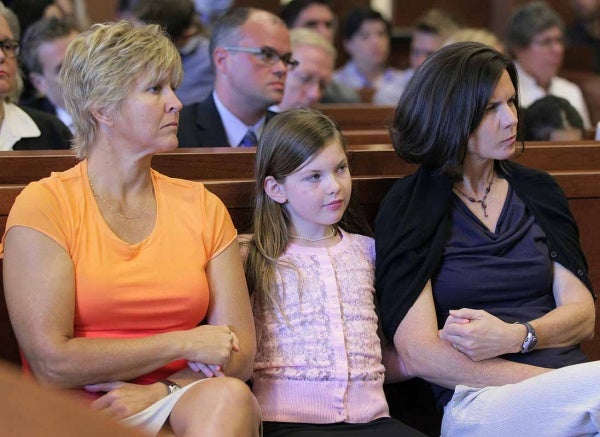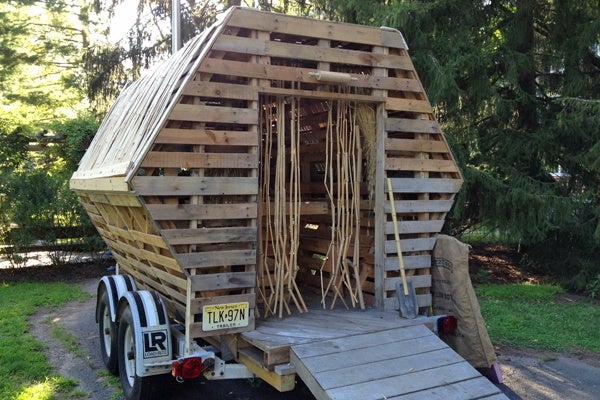Beehive inspires artist to create ‘B Home’ camper
This is part of a series from Ilene Dube of The Artful Blogger.
It’s a beautiful summer evening, and a bluegrass band is playing on an outdoor terrace at D&R Greenway’s Johnson Education Center in Princeton. There’s an art opening indoors, yet the art outdoors calls out as it absorbs the setting sun. The collection represents some of the most well-known sculptors and landscape artists of the region: Robert Cannon, Kate Graves, Harry Gordon, David Robinson.
The newest addition is by Peter Abrams, a metal sculptor who contributed to the 9/11 Memorial in Mercer County Park. He is installing the B home that will be in place for one year. The B home is a hexagonal, interconnecting modular shelter system made of upcycled sustainable materials. “It represents a fast, cheap way to provide shelter and security for those in need,” says the B home website. “It was inspired by the geometric efficiency and communal benefits of the honeycomb structure in beehives.”
The name has a triple meaning: Plan B, an alternative home, a fall-back shelter plan for those without one; a place to BE home, to rest, store modest belongings and feel safe; and a BEE home, inspired by the honeycomb and the cooperative community of bees.
Applications of the tessellated structure range from a children’s playhouse and artist studio to a temporary relief shelter. One B home used as an office for Princeton restaurateurs Raoul and Carlo Momo on their Kingston-based farm.
A crew of workers is putting together a B home from wooden shipping pallets. “There are two billion of these in the country,” says Abrams of the material he is repurposing. “They are cheap and available.”
For this night, he has brought along a prototype B home – it was commissioned by cultural anthropology Ph.D candidate Nadezhda Savova as a mobile bread house – a sort of community center, where people can come to make and bake bread and break down cultural barriers. The mobile bread home has made the rounds: National Night Out and Art All Night in Trenton, and the Sourland Music Festival. “It’s a place to sit and meet the neighbors, to have a tactile experience and learn to break bread,” Abrams says, leading a visitor through bamboo beaded doors.
Inside, there are herbs in pots, nested in openings in the wood. The structure is on wheels, and it feels somewhat like slatted wood RV, with a table and benches taking up most of the interior. The wooden table is covered with Plexiglas for ease of kneading the dough, and a rocket stove at one end is made of oil barrels. A sink, with a brass hose spigot, is not hooked up to a water source and not presently operational.
Over the table hangs a chandelier made from the wheel rim of a child’s bicycle and inverted wine bottles with the bottoms sawn off to contain candles. Abrams lights it with a torch. Mason jars, turned upside down, also fit into round openings and contain items to help demonstrate bread making, from wheat berries to something that looks like a preserved biscuit.
“It’s the archive of bread from past events,” says Abrams, ever the good host, spreading barley sacks on the benches for guests to sit on. “We want to show kids how their food is grown and harvested, and the cycle of where it comes from. Kids play with the dough, making shapes. Salt, flour, water and yeast – that’s all you need to make bread. That’s empowering to kids – they don’t have to go to the bodega to get something nutritious.”
Abrams refers to himself as a “reverse engineer” who is inspired by detritus, culling recycled materials out of the waste stream and transforming them into objects of desire. From 2001 until last spring, he ran Modern Metal Works in Trenton, a metal fabrication shop creating functional artwork — tables, chairs, fire bowls and architecture pieces — from recycled and reclaimed materials — tire rims, rebar and steel elevator cable. He was most well-known for the sculptural objects made from the wire rope first developed by the Roeblings, right here in Trenton.
In 2007, Abrams created the Trenton Atelier, a sort of artists’ collective that converts old bicycles and other metal objects into new, art-type objects, operating out of a 10,000 square foot industrial space. But by spring, Abrams was three years in arrears on taxes and had to vacate the space and sell everything. Abrams was ready to move on – the years of working with lead and cadmium had led to health problems.
He had been working with Princeton University Professors Catherine Peters and Wole Soboyejo in the EPICS program (Engineering Projects in Community Service) to create Power in a Box — providing portable renewable energy to recovering and off-the-grid communities to replace diesel generators. From that grew the B home. The first was fabricated in 2009 and “deployed in an abandoned building in Trenton for real-world testing.”
Abrams says he had a number of homeless friends whom he allowed to live in it. There are about six extant B homes, although he has rebuilt them many times. “You learn every time you take it apart and put it together again,” says Abrams, whose wife, Francine Besselaar, is an architect.
Once the B home is completed at the Greenway, school groups will be invited to learn about construction, using geometry, and have a hands-on building experience.
______________________________________________________
The Artful Blogger is written by Ilene Dube and offers a look inside the art world of the greater Princeton area. Ilene Dube is an award-winning arts writer and editor, as well as an artist, curator and activist for the arts.
WHYY is your source for fact-based, in-depth journalism and information. As a nonprofit organization, we rely on financial support from readers like you. Please give today.















